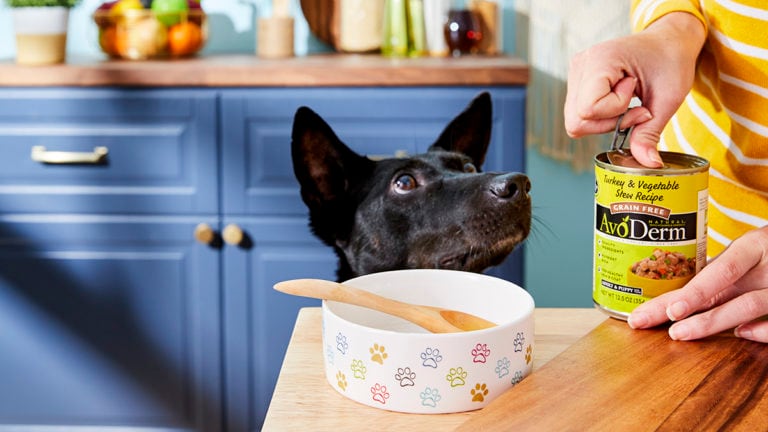If your dog is constantly scratching or experiencing recurring ear infections, you might be dealing with a dog food allergy. While canine food allergies can manifest in various ways, one thing is certain: They can make your dog very uncomfortable.
If you suspect your dog has a food allergy, it’s important to identify—and eliminate!—the source ASAP. It takes commitment and patience, but the result is a greatly improved quality of life for your four-legged best friend.
What Are Food Allergies in Dogs?
A dog food allergy is an immune system response in which the dog’s body reacts to a specific protein in their diet. The immune system mistakenly identifies the protein as a harmful substance and releases a chemical called histamine, which can lead to symptoms such as skin irritation, digestive issues, or even ear infections.
According to Shalsee Vigeant, DVM, medical director at Veterinary Emergency Group in Sugar Land, Texas, most doggy food allergies (about 85%) are identified by the age of 3. However, some pups may develop allergies after 4 years old.
Once allergies develop, they typically persist for life, although some may resolve or diminish as your dog gets older. That said, the likelihood of outgrowing the allergy decreases if your dog is diagnosed after the age of 2.
Food Allergies vs. Food Intolerances in Dogs
A food allergy should not be confused with a food sensitivity or intolerance in dogs. Food sensitivities, which are less severe, involve non-immune-related reactions that happen in the digestive tract.
Food sensitivities usually involve trouble digesting certain ingredients, which can cause vomiting, diarrhea, or gas, according to Sam Varon, DVM, practicing veterinarian at Broadway Veterinary Hospital in Sacramento, California.
To put it succinctly: Food allergies involve the immune system, while food sensitivities are localized in the digestive tract.
Dog Food Allergy Symptoms
Because food allergies are systemic, meaning they affect the whole body, signs can vary from gastrointestinal issues to skin rashes. Here are some symptoms you’re most likely to see in a dog with a food allergy:
- Itchy skin
- Recurring ear infections
- Chronic diarrhea
- Vomiting
- Gas/flatulence
- Recurrent anal gland infections
- Red, inflamed skin, especially around the face, paws, belly, and anal glands
- Smelly skin sores
- Scabbing or crusting on the skin
Causes of Food Allergies in Dogs
The exact causes of food allergies in dogs aren’t fully understood, according to Dr. Vigeant. It’s believed that allergies may develop due to issues with a dog’s immune system or overall health, but there isn’t enough research to fully explain this.
Some possible contributing factors are:
- Previous diet
- Genetics
- Immune status
- Health history
Dr. Varon adds that food allergies typically develop after repeated exposure to a specific ingredient, often a protein like chicken, beef, or dairy.
Dogs aren’t born with food allergies, he says; instead, they develop them over time as their immune system becomes sensitized to a particular protein. For example, a dog who has eaten the same food for years might suddenly develop an allergy to one of the proteins in it. But again, the “why” behind this remains somewhat of a mystery.
How Vets Diagnose a Dog Food Allergy
There aren’t any reliable blood tests for diagnosing food allergies, so Dr. Varon explains that an elimination diet remains the gold standard for identifying the allergen.
Your dog will be placed on a hypoallergenic diet for eight to 12 weeks to see if symptoms improve. If they do, the suspected allergens are reintroduced one at a time to identify which ingredient triggers the reaction. Once a specific trigger is identified, your dog will be diagnosed with a food allergy.
The steps of an elimination diet are pretty straightforward, but they do require time and patience:
- Planning: Work with your veterinarian to develop the right elimination diet for your dog.
- Eliminating: Feed your pup only the prescribed hypoallergenic dog foods for eight to 12 weeks. It’s important to avoid giving your dog any table scraps or treats during this period. While those puppy-dog eyes can be hard to resist, just one bite of an offending food can set you back to day one of the elimination process, especially if you don’t know exactly what they ate or which food caused the reaction.
- Reintroducing:
- If symptoms resolve, reintroduce one suspected allergen at a time to see if it triggers an allergic response. For example, give your dog a bite of chicken or beef.
- Make sure you only feed one suspect food at a time. If you feed your dog multiple allergens at once, you won’t be able to identify which one is triggering the reaction, and you’ll have to start over with the elimination process.
- Take detailed notes during this phase so you can monitor your dog’s reactions.
- Maintenance: Once you’ve figured out which proteins are triggering a reaction, work with your vet to determine the best long-term nutrition plan for your dog.
Dog Food Allergy Treatment
Dog food allergies can’t be cured in the traditional sense. Instead, they require long-term management in the form of avoiding the offending allergen completely. In other words, you need to put your dog on a diet that doesn’t contain any amount of the problematic ingredient.
In some cases, medications like antihistamines or corticosteroids may be prescribed to control symptoms during flare-ups.
You may also need to treat infections that often accompany dog food allergies, according to Dr. Varon. Bacterial or yeast infections may require antibiotics or antifungals.
Best Dog Food for Allergies
Hydrolyzed protein diets and novel protein diets are often recommended for dogs with food allergies.
Hydrolyzed protein diets use specialized dog foods where the protein is broken down into very small particles.
The idea is that because these proteins are so small and partially broken down already, your dog’s immune system is less likely to recognize and react to them in an allergic way.
Novel protein diets feature a protein source that your dog has likely never eaten before, such as duck, venison, alligator, or kangaroo.
According to Dr. Varon, food allergies tend to develop after the dog has been exposed to the allergen repeatedly for a prolonged period. By giving them a new type of protein, you reduce the chance of them having an allergic reaction.
Our vet experts recommend the following dog foods for allergies:
FAQs About Food Allergies in Dogs
Q:How can you tell if your dog is allergic to food?
A:The only reliable way to tell if your dog is allergic to food is to do an elimination diet and see if symptoms improve. There’s no reliable blood test for diagnosing food allergies.
Q:What is the most common dog food allergy?
A:The most common offenders for dog food allergies are beef (34%), dairy (17%), chicken (15%), and wheat (13%), according to Dr. Vigeant. However, allergies to soybeans, milk, eggs, corn, walnuts, and peanuts are also possible, she says.
Q:What foods make dogs itch?
A:Itching isn’t always caused by a food allergy, but it often is. Common culprits include beef, chicken, dairy, and wheat.
Q:Is my dog allergic to food or just sensitive?
A:It’s hard to tell by appearances alone. Allergies often trigger systemic symptoms like itchy or inflamed skin, recurring ear infections, and anal gland infections. Sensitivities, on the other hand, usually cause gastrointestinal issues such as vomiting, diarrhea, or gas.
Share:














